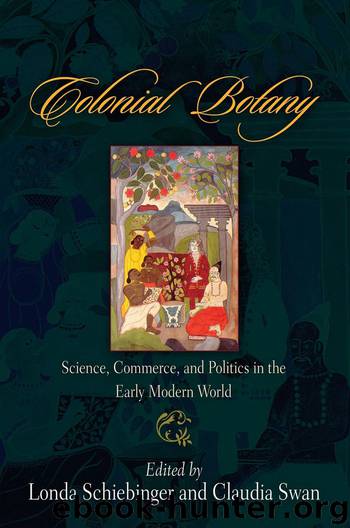Colonial Botany by Schiebinger Londa; Swan Claudia;

Author:Schiebinger, Londa; Swan, Claudia;
Language: eng
Format: epub
Publisher: University of Pennsylvania Press
Figure 10.3. From Jan Huyghen van Linschoten, Itinerario (Amsterdam: Cornelis Claesz, 1596), engraving. Van Linschoten’s report on his voyages and experiences with the Portuguese was an important early source of information for Dutch investors; his tempting descriptions of the rich harvests of pepper and other spices inspired the eventual formation of the Dutch East India Company. Reproduced courtesy of University Library of Amsterdam, Rare Book Department.
The figures in this print comfortably fit this mood of virgin paradise. Front and center, a putto-like child nibbles on what is labeled a “fig,” which he holds in one hand, and a “fig leaf”—again clearly labeled—is trailing from the other.35 Behind him a couple strolls along the riverbank, one nude, the other draped; other natives capsize a canoe, display their vaunted skill at climbing a tall palm, and crank a spit over an outdoor fire. While van Linschoten’s text reports poverty and weakness among the Canarijn people depicted here, this scene—idyllic, devoid of European presence—recalls nothing so much as a tropical garden of Eden.36
In contrast, the several massive publications by Johan Nieuhof (1618–72) recounting his travels in the service of the West and East India Companies bear witness to the changes that took place over the course of the seventeenth century. So comprehensive that they were still consulted as authoritative anthropological sources long into the eighteenth century, Nieuhof’s voluminous tomes treat in extensive detail not only colonial botany but also the appearance, customs, and beliefs of indigenous peoples; and yet their cataclysmic histories during this period are reduced to justifications of VOC actions in pursuit of the elusive spice monopoly.
Nieuhof’s 1665 account of a journey in the service of the VOC incorporates both verbal and visual documentation of the various botanical commodities that concerned the East India Company on this expedition.37 The plate illustrating a Nagel Boom (Clove Tree) is much more focused than Linschoten’s: here, indigenous figures are intent on the activities of harvest, corroborating the development—in the view of Europeans—of the commodity value of these natural wonders (see figure 10.4).
In his discussion of pepper, Nieuhof, like van Beverwyck, resorts to analogies with plants more familiar to Dutch readers, such as currants or grapevines, but then, as befits an eyewitness account, describes in more specific and accurate detail the types of pepper and its cultivation.38 Yet this pseudo-objectivity does not conceal the inherently superior attitude Nieuhof betrays toward indigenous peoples. His explanation of the process of shelling black peppercorns to make white pepper lets slip some unabashed prejudice: “after it has been steeped in Salt-water . . . the outward skin . . . swells, so that the white Pepper-corns within may be taken out with little or no trouble. . . . And if the lazy Indians were not so averse to labour, there might be much more white than black Pepper.”39 Nieuhof’s casual aside about “lazy Indians” offers but a hint of the vast cultural hubris that had made way for Coen’s ruthless policies.
More baldly, Nieuhof’s 1682 account of his travels
Download
This site does not store any files on its server. We only index and link to content provided by other sites. Please contact the content providers to delete copyright contents if any and email us, we'll remove relevant links or contents immediately.
| Anatomy | Animals |
| Bacteriology | Biochemistry |
| Bioelectricity | Bioinformatics |
| Biology | Biophysics |
| Biotechnology | Botany |
| Ecology | Genetics |
| Paleontology | Plants |
| Taxonomic Classification | Zoology |
Sapiens: A Brief History of Humankind by Yuval Noah Harari(13979)
The Tidewater Tales by John Barth(12391)
Mastermind: How to Think Like Sherlock Holmes by Maria Konnikova(6931)
Do No Harm Stories of Life, Death and Brain Surgery by Henry Marsh(6683)
The Thirst by Nesbo Jo(6432)
Why We Sleep: Unlocking the Power of Sleep and Dreams by Matthew Walker(6347)
Life 3.0: Being Human in the Age of Artificial Intelligence by Tegmark Max(5182)
Sapiens by Yuval Noah Harari(5117)
The Longevity Diet by Valter Longo(4854)
The Body: A Guide for Occupants by Bill Bryson(4577)
The Rules Do Not Apply by Ariel Levy(4520)
The Immortal Life of Henrietta Lacks by Rebecca Skloot(4247)
Why We Sleep by Matthew Walker(4190)
Animal Frequency by Melissa Alvarez(4147)
Yoga Anatomy by Kaminoff Leslie(4100)
The Hacking of the American Mind by Robert H. Lustig(4080)
All Creatures Great and Small by James Herriot(3980)
Barron's AP Biology by Goldberg M.S. Deborah T(3941)
Double Down (Diary of a Wimpy Kid Book 11) by Jeff Kinney(3920)
